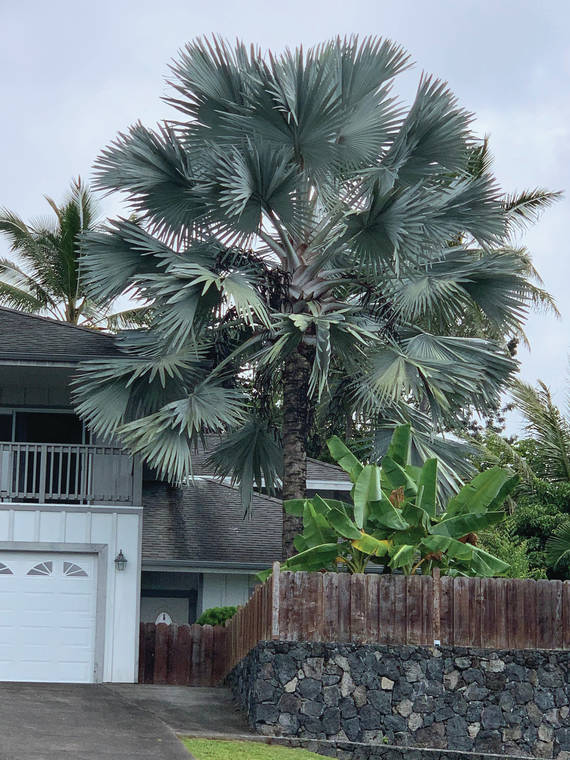When we think of the tropics, the first trees that come to mind are coconut palms gracing white coral sand beaches. Truly, these palms have been carried by humans throughout the tropical world over thousands of years.
Taxonomists, botanists and anthropologists have attempted to discover the origin of this valuable tree, but none are sure. One theory is that the specie evolved in the Australasian region hundreds of thousands of years ago since some of the earliest records are indicative. They may even have evolved when the interior of Australia was ocean. At any rate, the coconut palm is one of our favorite trees in Hawaii for landscape purposes, food and shelter. However, there are many more palms species to be found here. They generally come in two types. These are the feather leaf or pinnate and the fan leaf or palmate. Of course, there are always exceptions like the fishtail palms or Caryota species with bi-pinnate leaves.
Hawaiian gardens include hundreds of species of rare palms. As far as the USA is concerned, even the coconut palm can only be grown here and the southern tip of Florida. When it comes to species of palms in the world, there are thousands with more discovered each year. They come from the high mountains like the Andean wax palms that live at 13,000 feet above sea level to equatorial rainforest species like those from the Amazon. Desert palms are another large group, but none is quite so close to our Hawaiian hearts as the coconut palm. The coconut palm group is composed of scores of varieties including some dwarf types that should be used more in Hawaii. Not only are they shorter and easy to harvest, they are resistant to a devastating disease referred to as lethal yellowing. Unfortunately our endemic loulu palms (Pritchardia species) are very prone to this disease.
Palms here have few serious diseases at present. Hawaii’s palms may be affected by bud rot or stem bleeding disease that is often caused by physical damage such as unsanitary pruning equipment or climbing spikes. Most palms showing yellow or stunted growth have been found to be suffering from lack of fertilizer or water. For example, a recent report came from concerned citizens calling about the dead and dying trees around Kona. The trees simply need a balanced fertilizer plus minor elements, applied three to four times per year, and regular irrigation. All these problems are correctable, but if lethal yellowing ever gets in Hawaii, there’s no practical way of stopping destruction of our island’s palms. Not only would the coconut palm be destroyed, but over a hundred species of native and exotic palms would also die.
To realize the full potential threat of lethal yellowing, picture the streets of Waikiki and Kahala with tens of thousands of dying coconut palms in all stages of the disease, from the early brassy yellowing of the lower fronds through the collapsing of the crown and the final “telephone poling” when there is nothing more than a naked trunk.
This disease, originally thought to be a disease exclusively of coconut palms, occurs in the West Indies, Florida, Texas, Mexico and Africa. A similar disease occurs in the Philippines. Research showed that all varieties of coconuts are susceptible to lethal yellowing. The degree of susceptibility has been the point for developing varieties that are resistant. On the one end of the scale, the tall varieties are very susceptible. On the other end, the dwarf types are least susceptible. Crosses of the dwarf and tall are fairly resistant.
When lethal yellowing hit the mainland of Florida, it was discovered that many other palms species were also susceptible to the disease in varying degrees.
Florida embarked on a two-stage program to replant the stripped areas. Over half a million dwarf seed nuts were imported. The dwarf, while highly resistant to the disease also had the added benefit of easily harvested nuts and did not require expensive nut and leaf removal as with the tall varieties.
Hawaii is fortunate to be far from disease affected regions, so it is vital that we do not introduce this and other plant plagues. We can also make every effort to use many of the hundreds of disease resistant species besides the coconut palm to grace our home landscapes, parks and scenic roadways. It is important to cooperate with the state and federal Departments of Agriculture and follow all the rules of inspection to keep our palms free of disease and insect pests.



